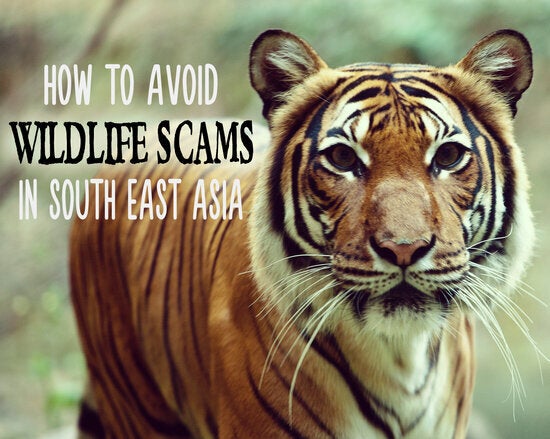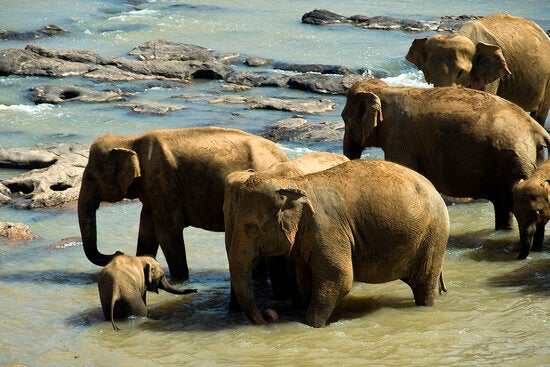
Original image courtesy of Sascha Kohlman
There are plenty of wildlife experiences that might draw you to South East Asia, with its brilliant diversity of tropical species and being home to some of the world's most iconic species. Unfortunately there are many practices for tourists that can have a negative effect on the wellbeing of these animals, such as increasing the demand for species that are often endangered in the wild to be poached for shows and street spectacles.
One quick and simple way you can help yourself judge a situation is to ask yourself: is the behaviour of this animal natural? For instance, would an elephant usually be found with a brush painting pictures in the wild, or a monkey performing tricks on a chain? Probably not. Another way is to look at the condition of the animal itself: does it have scarring, seem stressed or like it is being held in poor conditions?
Sometimes though it is hard to tell, especially if the owners are touting their establishments as an orphanage or sanctuary. So how can you ensure your actions are of a benefit rather than causing further harm to the animals?
Don't pose for pictures with animals on the street
The more people that have photos of themselves cuddling a leopard cub on Facebook, the more people that will want a similar photo of their own. Whether it's monkeys, snakes, elephants or big cat cubs, these animals subjected to long, stressful hours posing on the street and kept for extended periods in small transport cases are as far removed from their natural habitat as possible. The simplest answer for how to avoid this scam is to not take part in it. The less people that pay small change to have a photo taken, the less we will see animals on the street for that purpose.
Avoid the Tiger Temple at all costs
Whilst the Tiger Temple might sell itself as a sanctuary there is increasing evidence to the contrary. Some reports suggest the tigers are drugged to induce sleepiness that makes them placid enough for tourists to pose with, whilst others purely state the poor conditions and controversial 'conservation' status of the project. That there have still been cases of people being mauled by one of the tigers indicates just how unnatural the environment is for them. More worrying is that the temple may fuelling demand for young cubs taken from the wild, and recount cubs being sick from overfeeding from well-meaning tourists as described by one ex-volunteer. Tigers are endangered throughout South East Asia and, whilst you might not be able to take a tiger selfie, your money is better spent taking part in conservation trekking experiences that contribute research towards protecting these animals and their habitat in the wild.

Image courtesy of Malcolm Browne
Choose an Elephant Sanctuary over a trekking experience
After the 1989 logging ban in Thailand many mahouts and their elephants took to performing tricks and entertaining on the street as an alternative form of income. Subsequently, millions of foreign tourists visit Asia with an elephant ride on their bucket list and unwittingly support the capture of somewhere between 50 and 200 wild calves each year to be sold into the tourist industry. The elephants are put through extreme forms of violence and methods such as starvation in a process referred to as Phajaan to break their spirit and make them tame enough for humans to ride them. Once domesticated, elephants that are part of trekking camps will often be made to work exhausting hours each day even if they are sick, pregnant or elderly, in conditions that leave them in a degraded physical condition - especially if they are mounted with houdah (chair) to increase the load they can carry. Whilst elephants seem like sturdy animals they were not designed to carry heavy weights continually on their backs and this can cause them long-term harm. Instead of searching for an elephant riding experience, make sure you do your research and choose to visit a sanctuary instead where you can see elephants bathed, fed and interacting in a more natural environment. Visit non-profit NGO Elemotion's website www.elemotion.org for more information and a list of elephant friendly places.
Think twice before swimming with baited whale sharks
Swimming with whale sharks can mean big business in some places like Oslob in the Philippines, but you should smell something fishy about anywhere that can guarantee you a whale shark sighting. Whilst this form of wildlife tourism may be preferable to the now illegal hunting of the whale sharks, the alternative of baiting the sharks by feeding them and subsequently disrupting an already fragile marine ecosystem is at best ethically dubious. In Oslob there are rules in place such as staying four meters away from a whale shark with fines for touching as safety measures for both participants, but there is a disparity between what is said and what is enforced, especially considering what is possible to monitor when so many people are in the water. What a promise of guaranteed whale shark spotting does encourage is an attitude that wildlife is there for human consumption, which is ultimately detrimental to fostering respect for animals to remain wild. Take a boat and watch for whale sharks in the big, wide, open ocean to have an experience both you and the animal deserve.
For more information on how to make sure your travel doesn't have a negative impact on wildlife check out Care for the Wild's website www.right-tourism.org or discover Ten Ways to Travel Responsibly.